climate control Lancia Ypsilon 2012 Owner handbook (in English)
[x] Cancel search | Manufacturer: LANCIA, Model Year: 2012, Model line: Ypsilon, Model: Lancia Ypsilon 2012Pages: 307, PDF Size: 13.3 MB
Page 51 of 307

SWITCHING ON THE CLIMATE CONTROL
SYSTEM
The system can be switched on in various ways; it
is however advisable to press the AUTO button
and set the desired temperature on the display.
The climate control system allows you to
customise the temperatures requested.
The climate control system compressor works only
with the engine running and with an outside
temperature of above 0°C.
AUTOMATIC CLIMATE CONTROL SYSTEM
OPERATION
Press the AUTO button; the system will
automatically adjust:
❒the amount of air introduced into the passenger
compartment;
❒the distribution of the air in the passenger
compartment;
cancelling all previous manual adjustments.
During climate control system automatic
operation, the word AUTO appears on the display.During automatic operation it is still possible to
adjust the temperatures set and carry out the
following operations manually:
❒fan speed adjustment
❒air distribution selection
❒internal air recirculation on/off button;
❒climate control compressor activation.
WARNING
It is advisable not to use the internal
air recirculation function when the
outside temperature is low, because the
windows could mist rapidly.
49GETTING TO
KNOW YOUR CARSAFETY
STARTING AND
DRIVING
WARNING LIGHTS
AND MESSAGES
IN AN EMERGENCY
SERVICING AND
MAINTENANCE
TECHNICAL
SPECIFICATIONS
INDEX
Page 52 of 307
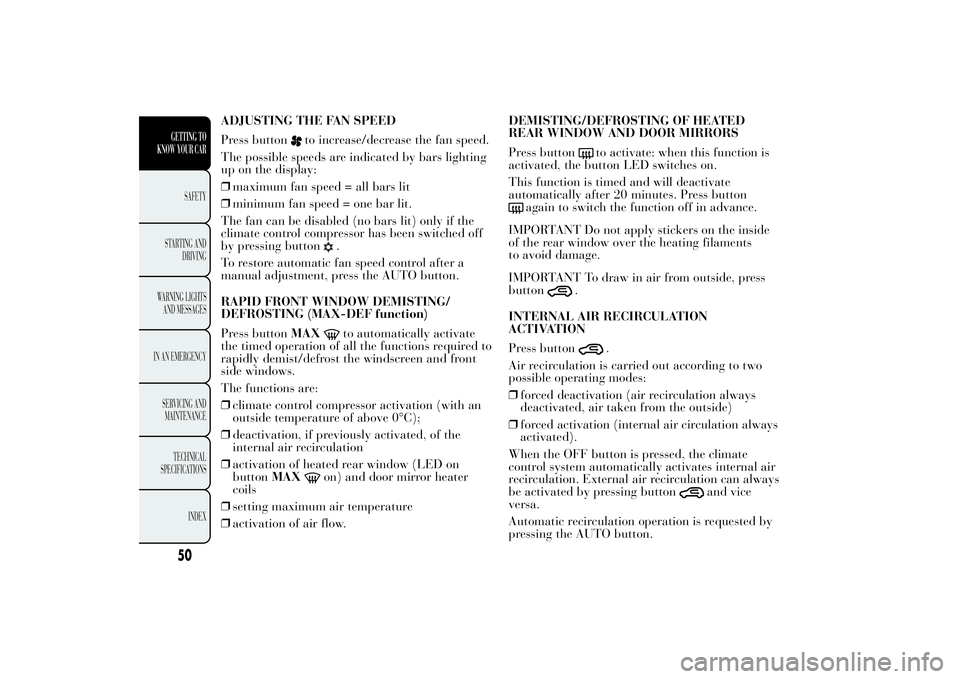
ADJUSTING THE FAN SPEED
Press button
to increase/decrease the fan speed.
The possible speeds are indicated by bars lighting
up on the display:
❒maximum fan speed = all bars lit
❒minimum fan speed = one bar lit.
The fan can be disabled (no bars lit) only if the
climate control compressor has been switched off
by pressing button
.
To restore automatic fan speed control after a
manual adjustment, press the AUTO button.
RAPID FRONT WINDOW DEMISTING/
DEFROSTING (MAX-DEF function)
Press buttonMAXto automatically activate
the timed operation of all the functions required to
rapidly demist/defrost the windscreen and front
side windows.
The functions are:
❒climate control compressor activation (with an
outside temperature of above 0°C);
❒deactivation, if previously activated, of the
internal air recirculation
❒activation of heated rear window (LED on
buttonMAX
on) and door mirror heater
coils
❒setting maximum air temperature
❒activation of air flow.DEMISTING/DEFROSTING OF HEATED
REAR WINDOW AND DOOR MIRRORS
Press button
to activate: when this function is
activated, the button LED switches on.
This function is timed and will deactivate
automatically after 20 minutes. Press button
again to switch the function off in advance.
IMPORTANT Do not apply stickers on the inside
of the rear window over the heating filaments
to avoid damage.
IMPORTANT To draw in air from outside, press
button
.
INTERNAL AIR RECIRCULATION
ACTIVATION
Press button
.
Air recirculation is carried out according to two
possible operating modes:
❒forced deactivation (air recirculation always
deactivated, air taken from the outside)
❒forced activation (internal air circulation always
activated).
When the OFF button is pressed, the climate
control system automatically activates internal air
recirculation. External air recirculation can always
be activated by pressing button
and vice
versa.
Automatic recirculation operation is requested by
pressing the AUTO button.
50GETTING TO
KNOW YOUR CAR
SAFETY
STARTING AND
DRIVING
WARNING LIGHTS
AND MESSAGES
IN AN EMERGENCY
SERVICING AND
MAINTENANCE
TECHNICAL
SPECIFICATIONS
INDEX
Page 53 of 307
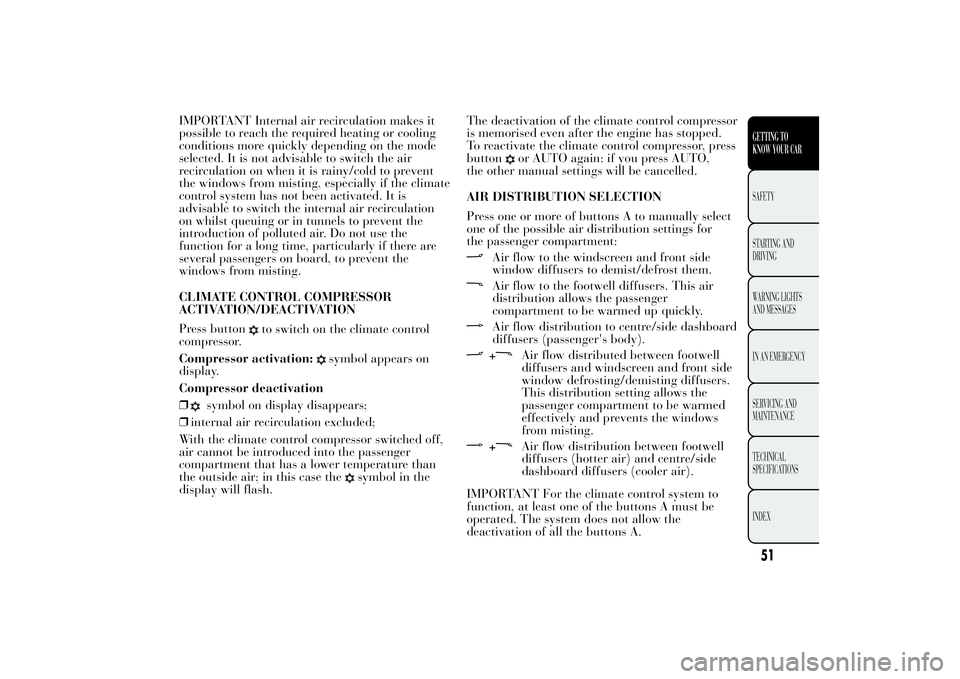
IMPORTANT Internal air recirculation makes it
possible to reach the required heating or cooling
conditions more quickly depending on the mode
selected. It is not advisable to switch the air
recirculation on when it is rainy/cold to prevent
the windows from misting, especially if the climate
control system has not been activated. It is
advisable to switch the internal air recirculation
on whilst queuing or in tunnels to prevent the
introduction of polluted air. Do not use the
function for a long time, particularly if there are
several passengers on board, to prevent the
windows from misting.
CLIMATE CONTROL COMPRESSOR
ACTIVATION/DEACTIVATION
Press button
to switch on the climate control
compressor.
Compressor activation:
symbol appears on
display.
Compressor deactivation
❒
symbol on display disappears;
❒internal air recirculation excluded;
With the climate control compressor switched off,
air cannot be introduced into the passenger
compartment that has a lower temperature than
the outside air; in this case the
symbol in the
display will flash.The deactivation of the climate control compressor
is memorised even after the engine has stopped.
To reactivate the climate control compressor, press
button
or AUTO again: if you press AUTO,
the other manual settings will be cancelled.
AIR DISTRIBUTION SELECTION
Press one or more of buttons A to manually select
one of the possible air distribution settings for
the passenger compartment:
Air flow to the windscreen and front side
window diffusers to demist/defrost them.Air flow to the footwell diffusers. This air
distribution allows the passenger
compartment to be warmed up quickly.Air flow distribution to centre/side dashboard
diffusers (passenger's body).+
Air flow distributed between footwell
diffusers and windscreen and front side
window defrosting/demisting diffusers.
This distribution setting allows the
passenger compartment to be warmed
effectively and prevents the windows
from misting.
+
Air flow distribution between footwell
diffusers (hotter air) and centre/side
dashboard diffusers (cooler air).
IMPORTANT For the climate control system to
function, at least one of the buttons A must be
operated. The system does not allow the
deactivation of all the buttons A.
51GETTING TO
KNOW YOUR CARSAFETY
STARTING AND
DRIVING
WARNING LIGHTS
AND MESSAGES
IN AN EMERGENCY
SERVICING AND
MAINTENANCE
TECHNICAL
SPECIFICATIONS
INDEX
Page 54 of 307
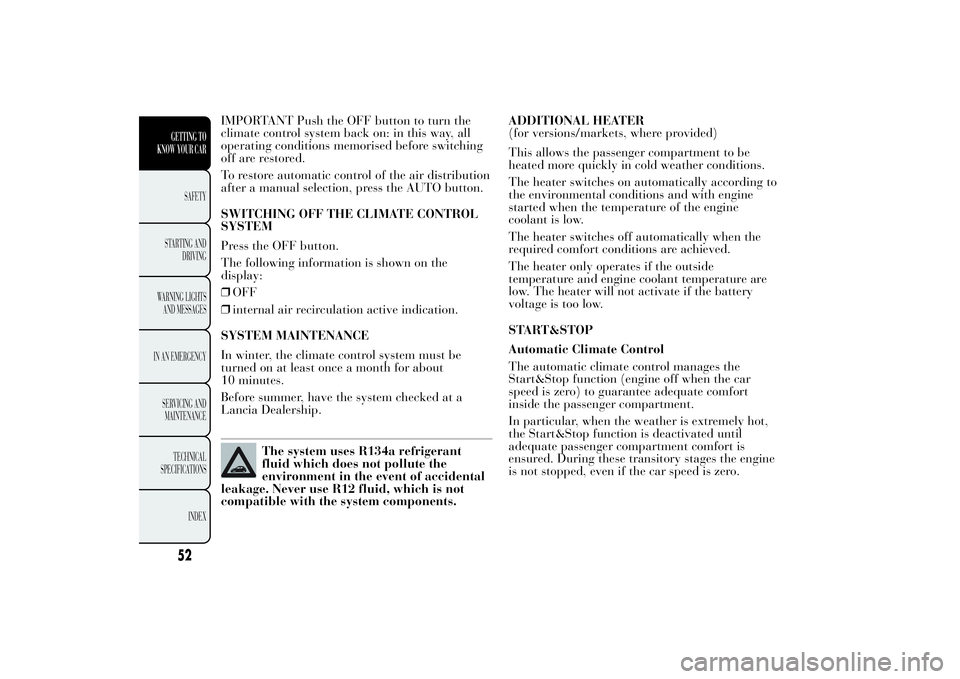
IMPORTANT Push the OFF button to turn the
climate control system back on: in this way, all
operating conditions memorised before switching
off are restored.
To restore automatic control of the air distribution
after a manual selection, press the AUTO button.
SWITCHING OFF THE CLIMATE CONTROL
SYSTEM
Press the OFF button.
The following information is shown on the
display:
❒OFF
❒internal air recirculation active indication.
SYSTEM MAINTENANCE
In winter, the climate control system must be
turned on at least once a month for about
10 minutes.
Before summer, have the system checked at a
Lancia Dealership.
The system uses R134a refrigerant
fluid which does not pollute the
environment in the event of accidental
leakage. Never use R12 fluid, which is not
compatible with the system components.ADDITIONAL HEATER
(for versions/markets, where provided)
This allows the passenger compartment to be
heated more quickly in cold weather conditions.
The heater switches on automatically according to
the environmental conditions and with engine
started when the temperature of the engine
coolant is low.
The heater switches off automatically when the
required comfort conditions are achieved.
The heater only operates if the outside
temperature and engine coolant temperature are
low. The heater will not activate if the battery
voltage is too low.
START&STOP
Automatic Climate Control
The automatic climate control manages the
Start&Stop function (engine off when the car
speed is zero) to guarantee adequate comfort
inside the passenger compartment.
In particular, when the weather is extremely hot,
the Start&Stop function is deactivated until
adequate passenger compartment comfort is
ensured. During these transitory stages the engine
is not stopped, even if the car speed is zero.
52GETTING TO
KNOW YOUR CAR
SAFETY
STARTING AND
DRIVING
WARNING LIGHTS
AND MESSAGES
IN AN EMERGENCY
SERVICING AND
MAINTENANCE
TECHNICAL
SPECIFICATIONS
INDEX
Page 55 of 307
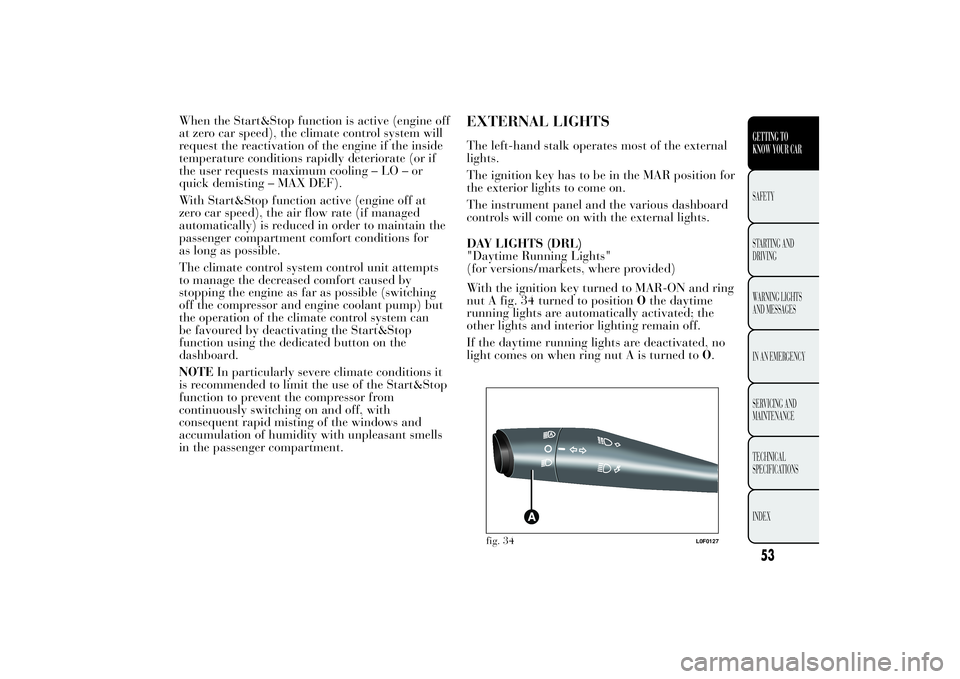
When the Start&Stop function is active (engine off
at zero car speed), the climate control system will
request the reactivation of the engine if the inside
temperature conditions rapidly deteriorate (or if
the user requests maximum cooling – LO – or
quick demisting – MAX DEF).
With Start&Stop function active (engine off at
zero car speed), the air flow rate (if managed
automatically) is reduced in order to maintain the
passenger compartment comfort conditions for
as long as possible.
The climate control system control unit attempts
to manage the decreased comfort caused by
stopping the engine as far as possible (switching
off the compressor and engine coolant pump) but
the operation of the climate control system can
be favoured by deactivating the Start&Stop
function using the dedicated button on the
dashboard.
NOTEIn particularly severe climate conditions it
is recommended to limit the use of the Start&Stop
function to prevent the compressor from
continuously switching on and off, with
consequent rapid misting of the windows and
accumulation of humidity with unpleasant smells
in the passenger compartment.
EXTERNAL LIGHTSThe left-hand stalk operates most of the external
lights.
The ignition key has to be in the MAR position for
the exterior lights to come on.
The instrument panel and the various dashboard
controls will come on with the external lights.
DAY LIGHTS (DRL)
"Daytime Running Lights"
(for versions/markets, where provided)
With the ignition key turned to MAR-ON and ring
nut A fig. 34 turned to positionOthe daytime
running lights are automatically activated; the
other lights and interior lighting remain off.
If the daytime running lights are deactivated, no
light comes on when ring nut A is turned toO.
fig. 34
L0F0127
53GETTING TO
KNOW YOUR CARSAFETY
STARTING AND
DRIVING
WARNING LIGHTS
AND MESSAGES
IN AN EMERGENCY
SERVICING AND
MAINTENANCE
TECHNICAL
SPECIFICATIONS
INDEX
Page 96 of 307

The LED above the
button is on when the
system is deactivated.
ENGINE STOPPING FAILURE CONDITIONS
When the system is active, due to comfort,
emission control and safety reasons, the engine
does not stop in some conditions, among which:
❒engine still cold;
❒especially cold outside temperature;
❒battery not sufficiently charged;
❒heated rear window activated;
❒windscreen wipers working at maximum speed;
❒particulate filter regeneration (DPF) in progress
(diesel engines only);
❒driver's door not shut;
❒driver's seat belt not fastened;
❒reverse gear engaged (for example, for parking
manoeuvres);
❒for versions equipped with automatic climate
control (for versions/markets, where provided),
if an adequate level of thermal comfort has
not been reached or with MAX-DEF activation;
❒during the first period of use, to initialise the
system.
If climate comfort is to be favoured, the
Start&Stop system can be disabled,
for a continuous operation of the
climate control system.ENGINE RESTARTING CONDITIONS
For reasons of comfort, to limit harmful emissions
and for safety purposes, the engine can restart
automatically without any action by the driver if
certain conditions are met, including:
❒battery not sufficiently charged;
❒windscreen wipers working at maximum speed;
❒reduced braking system vacuum (e.g. if the
brake pedal is pressed repeatedly);
❒car moving (e.g. when driving on roads with a
gradient);
❒engine stopping by Start&Stop system for over
3 minutes;
❒for versions equipped with automatic climate
control (for versions/markets where provided),
to enable suitable thermal comfort or with
MAX-DEF activation.
With gear engaged, automatic engine restarting is
possible only by fully depressing the clutch pedal.
The driver is informed by the displaying of a
message on the display and - for versions/markets,
where provided - by the flashing of the symbol
.
94GETTING TO
KNOW YOUR CAR
SAFETY
STARTING AND
DRIVING
WARNING LIGHTS
AND MESSAGES
IN AN EMERGENCY
SERVICING AND
MAINTENANCE
TECHNICAL
SPECIFICATIONS
INDEX
Page 151 of 307
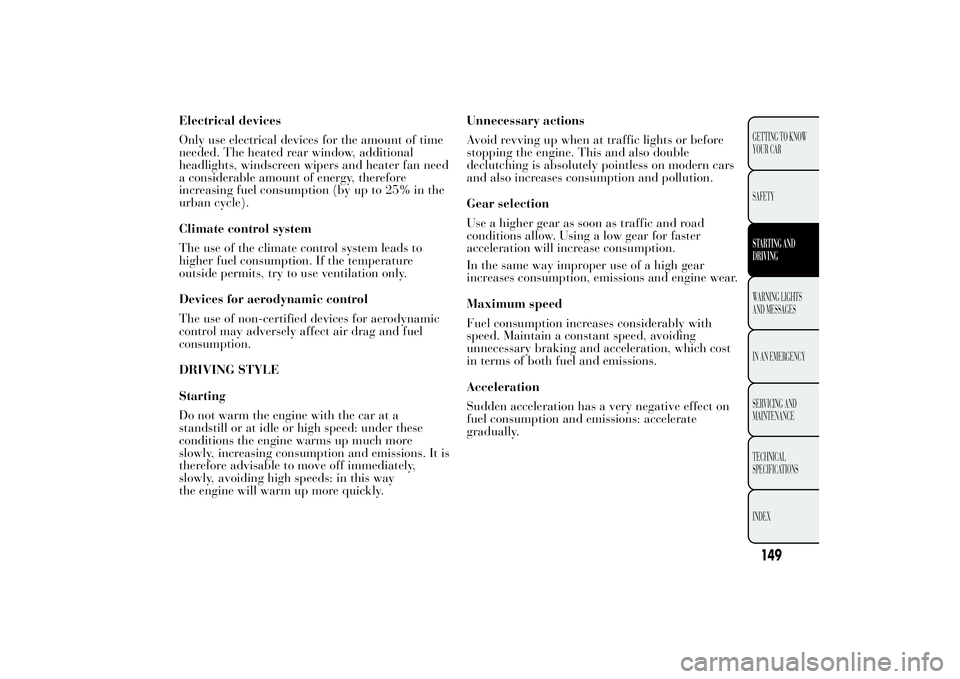
Electrical devices
Only use electrical devices for the amount of time
needed. The heated rear window, additional
headlights, windscreen wipers and heater fan need
a considerable amount of energy, therefore
increasing fuel consumption (by up to 25% in the
urban cycle).
Climate control system
The use of the climate control system leads to
higher fuel consumption. If the temperature
outside permits, try to use ventilation only.
Devices for aerodynamic control
The use of non-certified devices for aerodynamic
control may adversely affect air drag and fuel
consumption.
DRIVING STYLE
Starting
Do not warm the engine with the car at a
standstill or at idle or high speed: under these
conditions the engine warms up much more
slowly, increasing consumption and emissions. It is
therefore advisable to move off immediately,
slowly, avoiding high speeds: in this way
the engine will warm up more quickly.Unnecessary actions
Avoid revving up when at traffic lights or before
stopping the engine. This and also double
declutching is absolutely pointless on modern cars
and also increases consumption and pollution.
Gear selection
Use a higher gear as soon as traffic and road
conditions allow. Using a low gear for faster
acceleration will increase consumption.
In the same way improper use of a high gear
increases consumption, emissions and engine wear.
Maximum speed
Fuel consumption increases considerably with
speed. Maintain a constant speed, avoiding
unnecessary braking and acceleration, which cost
in terms of both fuel and emissions.
Acceleration
Sudden acceleration has a very negative effect on
fuel consumption and emissions: accelerate
gradually.
149GETTING TO KNOW
YOUR CAR
SAFETYSTARTING AND
DRIVINGWARNING LIGHTS
AND MESSAGES
IN AN EMERGENCY
SERVICING AND
MAINTENANCE
TECHNICAL
SPECIFICATIONS
INDEX
Page 252 of 307

FUEL CONSUMPTIONThe fuel consumption figures given in the table below are determined on the basis of the type-approval
tests laid down by specific European Directives.
The following procedures are followed to measure consumption:
❒urban cycle: cold starting followed by driving that simulates urban use of the car;
❒extra-urban cycle: frequent accelerating in all gears, simulating extraurban use of the car: speed
varies between 0 and 120 km/h;
❒combined fuel consumption: calculated with a weighting of approximately 37% of the urban cycle
and 63% of the extra-urban cycle.
IMPORTANT The type of route, traffic conditions, weather conditions, driving style, general condition
of the car, trim level/equipment/accessories, use of the climate control, car load, presence of roof racks
and other situations that adversely affect the aerodynamics or wind resistance lead to different fuel
consumption figures than those measured.
FUEL CONSUMPTION ACCORDING TO THE CURRENT EUROPEAN DIRECTIVE (litres/100
km)Versions Urban Extra-urban Combined
0.9 TwinAir 85 HP5.0 3.8 4.2
1.2 8V 69 HP6.4 4.1 4.9
1.3 16V MultiJet4.7 3.2 3.8
250
GETTING TO KNOW
YOUR CAR
SAFETY
STARTING AND
DRIVING
WARNING LIGHTS
AND MESSAGES
IN AN EMERGENCY
SERVICING AND
MAINTENANCE
TECHNICAL
SPECIFICATIONS
INDEX
Page 301 of 307

Index
ABS (system) ....................... 88
ABS system .......................... 88
Airbag ................................ 137
– Deactivation of
passenger side front
airbag and side bag ........ 139
– side bag .......................... 139
– window bag .................... 140
Airbags
– front ............................... 137
Air cleaner .......................... 217
Ashtray ................................ 71
ASR system .......................... 91
ASR (system) ....................... 91
Automatic climate control .... 45
– controls............................ 45
– maintenance .................... 52Battery (charge) ................. 199
Battery................................ 217
– advice for extending
lifetime ........................... 217
– replacement.................... 217
Body versions...................... 230
Bodywork– bodywork codes.............. 230
– maintenance ................... 224
– protection from
atmospheric agents ......... 223
– warranty ........................ 224
Bonnet ................................. 84
Brake Assist system .............. 92
Brake Assist (system) ........... 92
Brakes
– brake fluid level ............. 216
– specifications .................. 233
bulb replacement......... 182-184
Bulb replacement
– external lights................. 180
– interior lights.................. 186
Car dimensions................... 242
Carrying children safely ...... 129
– Carrying children safely . 129
– child seats ...................... 136
– Setup for "Isofix" child
seat ................................ 134
Central air diffusers ............. 40
Changing a wheel ............... 169
Checking levels .... 211-212-213
Child seats (compliance
for use) ............................. 133Cigar lighter ......................... 71
CITY function ...................... 98
Cleaning and maintenance
– bodywork ....................... 223
– car interior ..................... 226
– engine compartment ....... 225
– front headlights .............. 225
– Leather parts.................. 227
– Leather seats .................. 227
– Plastic and coated parts.. 226
– seats ............................... 226
– windows ......................... 225
Climate control .................... 40
– Passenger compartment
air diffusers ..................... 41
Climatic comfort .................. 41
Clutch................................. 232
CO
2emissions..................... 251
Conditions of use ................ 150
Control panel and
instruments ........................ 6
Controls .......................... 67-78
Cruise control....................... 61
D
ashboard........................... 5
Daytime running lights
(DRL)
299GETTING TO
KNOW YOUR CAR
SAFETY
STARTING AND
DRIVING
WARNING LIGHTS
AND MESSAGES
IN AN EMERGENCY
SERVICING AND
MAINTENANCE
TECHNICAL
SPECIFICATIONSINDEX
Page 303 of 307
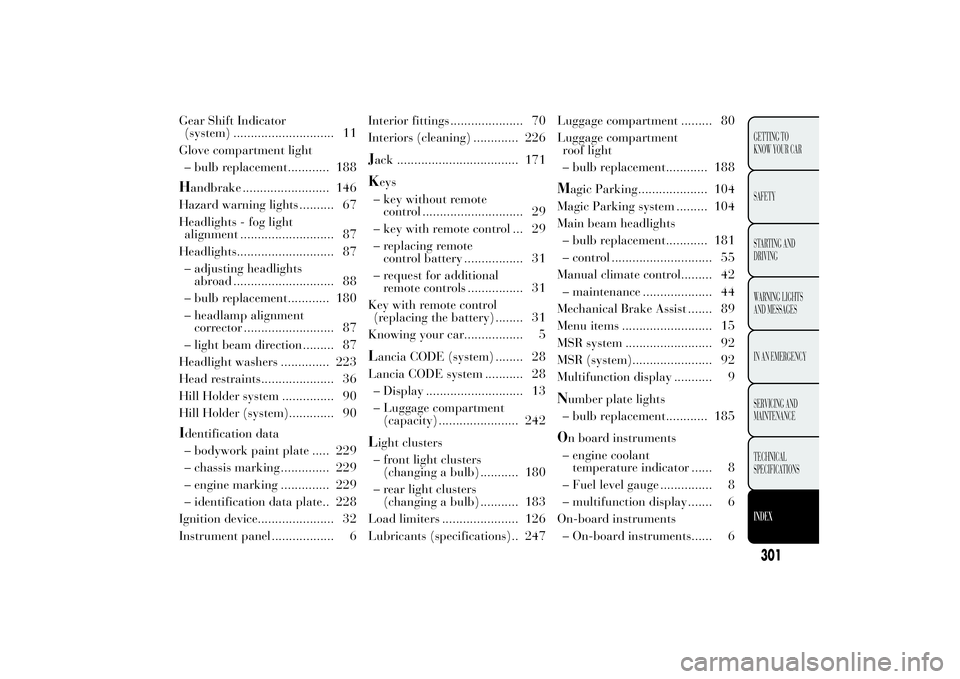
Gear Shift Indicator
(system) ............................. 11
Glove compartment light
– bulb replacement............ 188H
andbrake ......................... 146
Hazard warning lights .......... 67
Headlights - fog light
alignment ........................... 87
Headlights............................ 87
– adjusting headlights
abroad ............................. 88
– bulb replacement............ 180
– headlamp alignment
corrector .......................... 87
– light beam direction ......... 87
Headlight washers .............. 223
Head restraints..................... 36
Hill Holder system ............... 90
Hill Holder (system)............. 90
Identification data
– bodywork paint plate ..... 229
– chassis marking .............. 229
– engine marking .............. 229
– identification data plate.. 228
Ignition device...................... 32
Instrument panel .................. 6Interior fittings ..................... 70
Interiors (cleaning) ............. 226
Jack ................................... 171K
eys
– key without remote
control ............................. 29
– key with remote control ... 29
– replacing remote
control battery ................. 31
– request for additional
remote controls ................ 31
Key with remote control
(replacing the battery) ........ 31
Knowing your car................. 5
Lancia CODE (system) ........ 28
Lancia CODE system ........... 28
– Display ............................ 13
– Luggage compartment
(capacity) ....................... 242Light clusters
– front light clusters
(changing a bulb) ........... 180
– rear light clusters
(changing a bulb) ........... 183
Load limiters ...................... 126
Lubricants (specifications).. 247Luggage compartment ......... 80
Luggage compartment
roof light
– bulb replacement............ 188
M
agic Parking.................... 104
Magic Parking system ......... 104
Main beam headlights
– bulb replacement............ 181
– control ............................. 55
Manual climate control......... 42
– maintenance .................... 44
Mechanical Brake Assist ....... 89
Menu items .......................... 15
MSR system ......................... 92
MSR (system)....................... 92
Multifunction display ........... 9
Number plate lights
– bulb replacement............ 185On board instruments
– engine coolant
temperature indicator ...... 8
– Fuel level gauge ............... 8
– multifunction display ....... 6
On-board instruments
– On-board instruments...... 6
301GETTING TO
KNOW YOUR CAR
SAFETY
STARTING AND
DRIVING
WARNING LIGHTS
AND MESSAGES
IN AN EMERGENCY
SERVICING AND
MAINTENANCE
TECHNICAL
SPECIFICATIONSINDEX